Key Takeaways
- 5G and AI synergy is creating a technological revolution that will transform industries with ultra-fast speeds and real-time processing capabilities.
- Smart cities, healthcare, autonomous vehicles, AR/VR, and factory automation are at the forefront of 5G-AI implementation with tangible results already visible.
- Edge computing serves as the critical infrastructure enabling 5G-AI applications by processing data locally and dramatically reducing latency.
- Security challenges in the expanding 5G-AI ecosystem require innovative approaches, with AI-powered solutions emerging as the primary defense.
- The future roadmap of connectivity points toward 6G development, which will be AI-native from inception and operate on terahertz frequencies.

“5G & Artificial Intelligence” from www.hsc.com and used with no modifications.
5G and AI: The Perfect Tech Storm Transforming Our World
The convergence of 5G and artificial intelligence is creating a technological perfect storm that’s quietly revolutionizing how we live, work, and interact with the world around us. This powerful combination is not just an incremental improvement over previous technologies – it represents a fundamental shift in what’s possible. The enhanced connectivity of 5G networks provides the essential foundation that AI systems need to deliver their full potential across virtually every industry and aspect of daily life.
At Market Business Watch, we’re tracking how this fusion is already transforming business operations and creating entirely new market opportunities. The integration of these technologies isn’t just about faster downloads or smarter algorithms in isolation – it’s about what happens when ultra-responsive networks meet intelligent systems capable of making decisions in milliseconds. This combination is enabling innovations that were previously impossible due to connectivity constraints.
While much attention focuses on consumer applications like enhanced mobile experiences, the most profound impacts are happening in industrial settings, healthcare, transportation, and urban infrastructure. Organizations implementing 5G-powered AI solutions are seeing dramatic improvements in operational efficiency, predictive maintenance capabilities, and the ability to process massive datasets in real-time at the network edge. The result is a technological ecosystem where physical and digital systems can interact seamlessly, creating a foundation for truly intelligent environments.
How 5G’s Ultra-Fast Speeds Power AI Applications
The raw speed of 5G networks – reaching theoretical peaks of 10 Gbps – creates a communications backbone capable of handling the enormous data requirements of sophisticated AI systems. This represents up to a 100x improvement over 4G LTE networks, fundamentally changing what’s possible in mobile computing environments. More importantly, 5G’s dramatically reduced latency (as low as 1 millisecond) enables near-instantaneous communication between devices and AI processing systems, whether in the cloud or at the network edge.
This speed differential isn’t just about faster file downloads; it’s about enabling continuous data streams from multiple sources simultaneously. Consider autonomous vehicles, which generate up to 25GB of data per hour from various sensors. 5G networks can transmit this data to AI systems for real-time processing and decision-making, allowing vehicles to respond to changing road conditions instantly. Similarly, industrial IoT deployments can now support thousands of connected sensors per square kilometer, each feeding data to AI analytics platforms that optimize operations in real-time.
The enhanced capacity of 5G networks also addresses a critical limitation of previous wireless standards – network congestion in densely populated areas. With the ability to support up to 1 million connected devices per square kilometer (compared to around 4,000 with 4G), 5G enables widespread deployment of AI-powered devices even in crowded urban environments or massive industrial facilities. This massive connection density opens the door to truly ubiquitous AI presence across our physical world.
“Looking ahead to the emergence of 6G and future wireless technologies, AI will be crucial in managing these complex networks, ensuring faster, more reliable connections that can support advanced applications.” – Matthieu, Network Infrastructure Specialist
Real-Time Processing Capabilities That Change Everything
The revolutionary aspect of 5G-AI integration isn’t just about raw speed – it’s about achieving genuine real-time processing capabilities. The sub-10 millisecond latency of 5G networks essentially eliminates the delay between data generation and AI-driven responses, creating possibilities for applications where even tiny delays could be problematic or dangerous. This near-instantaneous processing enables split-second decision making in critical scenarios like emergency response systems, medical monitoring, and industrial safety applications.
Real-time capabilities fundamentally change how AI systems can interact with the physical world. In manufacturing environments, production lines can be dynamically adjusted based on quality control AI that analyzes products as they’re being created. In healthcare, patient monitoring systems can immediately alert medical staff to concerning changes in vital signs, with AI assistance providing context and suggested interventions. The elimination of processing delays means AI can now function as a truly responsive participant in time-sensitive operations rather than just an analytical tool.
Perhaps most significantly, this real-time processing creates new opportunities for human-AI collaboration in complex environments. Consider augmented reality applications where AI can analyze what you’re seeing and provide contextual information overlaid on your view without noticeable delay. This capability enables everything from guided technical repairs to enhanced training scenarios where AI coaches can provide immediate feedback as you work. The fluid interaction between human expertise and AI capabilities represents a new paradigm in how we approach complex tasks.
The 5 Most Groundbreaking AI-5G Applications Already Here
While much discussion of 5G and AI focuses on future possibilities, numerous groundbreaking applications are already operational today, delivering tangible benefits across multiple sectors. These early implementations provide a window into how these technologies will transform daily life and business operations in the coming years. From urban infrastructure to healthcare and transportation, the integration of high-speed connectivity with artificial intelligence is creating solutions to longstanding challenges that previous technology generations couldn’t adequately address.
Smart Cities That Actually Work

“awards recognize 14 UW-Madison students …” from news.wisc.edu and used with no modifications.
Smart city implementations have frequently fallen short of their promise in the past, limited by inadequate connectivity infrastructure and inability to process diverse data streams effectively. The combination of 5G networks and AI is finally changing this reality, enabling truly responsive urban environments. Cities like Barcelona, Singapore, and Seoul are deploying 5G-connected sensor networks that monitor everything from air quality to traffic patterns, with AI systems analyzing this data to make real-time adjustments to city operations.
In traffic management, AI-powered systems analyze data from thousands of sensors and cameras to optimize traffic flow, reducing congestion by up to 30% in pilot implementations. Smart lighting systems automatically adjust based on pedestrian and vehicle presence, reducing energy consumption while maintaining safety. Waste management operations use fill-level sensors in containers that trigger collection only when necessary, optimizing routes and reducing fuel consumption by up to 40%. For more insights on how 5G and AI are advancing connectivity, explore the latest innovations.
Perhaps most impressively, these systems now operate as interconnected ecosystems rather than isolated applications. When a major event occurs, traffic systems automatically coordinate with public transportation, emergency services are pre-positioned based on AI predictions, and residents receive personalized notifications with optimal travel recommendations. This level of coordination requires both the massive bandwidth of 5G to handle simultaneous data streams and the processing power of AI to make sense of complex urban patterns.
Healthcare Revolution: Remote Surgeries and AI Diagnostics

“remote surgical assistance …” from www.medicaldevice-network.com and used with no modifications.
The healthcare sector is experiencing a particularly dramatic transformation through 5G-AI integration, with applications that directly impact patient outcomes. Remote surgery, long discussed as a theoretical possibility, has become reality with procedures performed by surgeons controlling robotic systems from hundreds or even thousands of miles away. These systems rely on 5G’s ultra-reliable low-latency communication (URLLC) capabilities, ensuring that surgeon movements are transmitted instantaneously to surgical robots, with haptic feedback providing tactile sensations that mimic in-person procedures.
To understand the backbone of this technological advancement, you can explore what is edge computing and its role in enhancing connectivity and data processing.
AI diagnostic systems connected through 5G networks now provide real-time analysis of medical imagery, lab results, and patient vital signs. Radiologists are using AI assistants that can identify potential abnormalities in scans within seconds, highlighting areas of concern and providing probability assessments for various conditions. These systems dramatically increase diagnostic speed and accuracy, particularly in underserved areas where specialist expertise may be limited.
Continuous patient monitoring through 5G-connected wearables has evolved beyond simple fitness tracking to comprehensive health management. Advanced systems now track multiple vital signs simultaneously, using AI to detect subtle patterns that might indicate developing health issues before obvious symptoms appear. For patients with chronic conditions, these systems can adjust medication delivery in real-time or alert healthcare providers to potential complications, significantly reducing hospitalization rates.
Self-Driving Cars Finally Becoming Reality
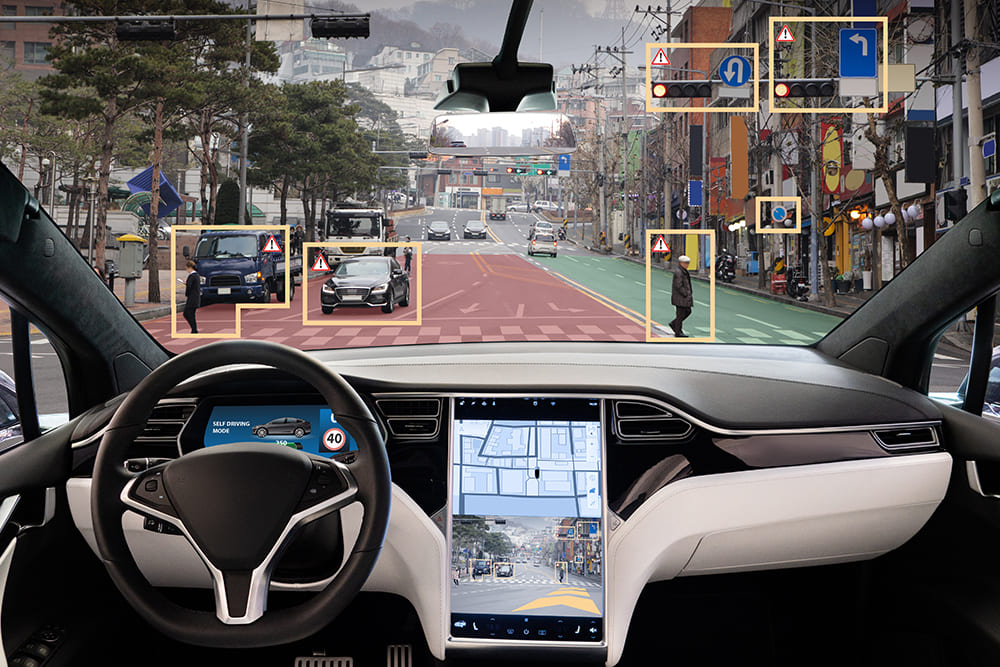
“Autonomous Cars …” from bernardmarr.com and used with no modifications.
Autonomous vehicle technology has made remarkable progress in recent years, but widespread deployment has been constrained by connectivity limitations. The high-speed, low-latency nature of 5G networks, combined with AI processing capabilities, is finally enabling the reliable vehicle-to-everything (V2X) communication necessary for safe autonomous driving in complex environments. Vehicles can now communicate not just with infrastructure but with each other, sharing sensor data and coordinating movements to optimize traffic flow and prevent accidents.
AI systems within these vehicles process data from multiple sensors (cameras, lidar, radar) to create comprehensive environmental awareness, with 5G enabling communication with cloud-based AI for more complex decision-making. This distributed intelligence approach allows vehicles to make basic safety decisions locally while leveraging more sophisticated analysis from centralized systems for navigation optimization and unusual scenario handling. The result is autonomous driving systems that can adapt to changing road conditions, construction zones, and unexpected obstacles far more effectively than previous generations.
Beyond passenger vehicles, autonomous delivery systems are rapidly transforming logistics networks. From sidewalk delivery robots to full-size autonomous trucks, these systems coordinate through 5G networks and AI routing systems to optimize delivery paths, adjust to traffic conditions, and coordinate handoffs between different transportation modes. Companies like Waymo, TuSimple, and Nuro are already operating commercial services in multiple markets, demonstrating the viability of these technologies for everyday logistics operations.
AR/VR Experiences Without the Lag
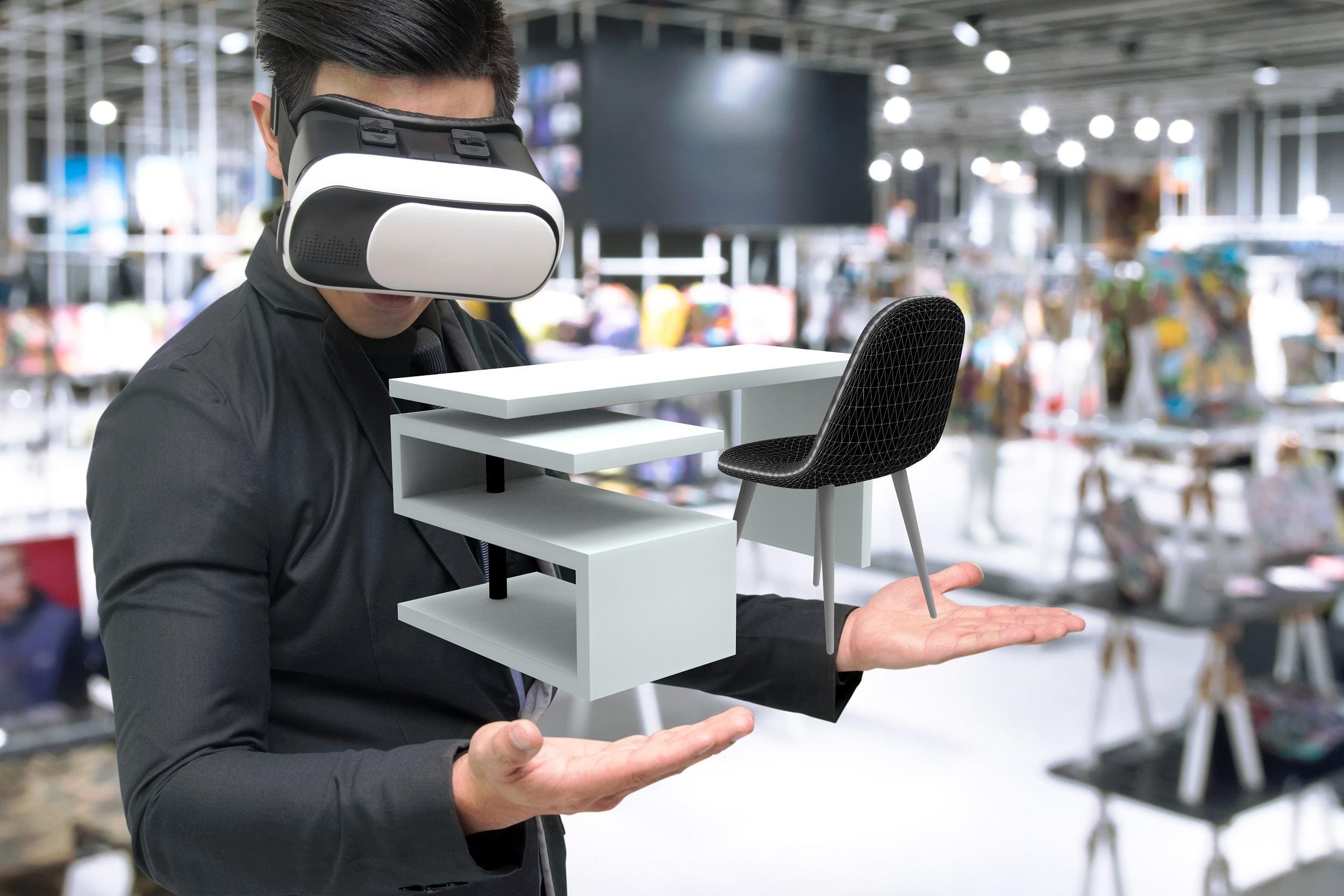
“Augmented And Virtual Reality In Retail” from www.forbes.com and used with no modifications.
Augmented and virtual reality applications have long promised to transform how we work, learn, and entertain ourselves, but have been constrained by connectivity limitations. The high bandwidth and low latency of 5G networks have eliminated many of these constraints, enabling AR/VR experiences that are both more immersive and more practical for everyday use. Complex virtual environments can now be rendered partially in the cloud and streamed to headsets, dramatically reducing the weight and cost of AR/VR devices while improving visual quality.
In industrial settings, maintenance technicians use 5G-connected AR headsets that overlay repair instructions directly on machinery, with AI systems identifying components and tracking work progress. Remote experts can join these sessions in real-time, seeing exactly what the on-site technician sees and providing guidance through visual annotations that appear in the technician’s field of view. These applications have reduced repair times by up to 50% while improving accuracy and reducing the need for travel.
Educational applications of AR/VR have similarly advanced through 5G-AI integration. Students can now interact with detailed simulations of historical events, scientific phenomena, or complex systems, with AI tutors that adapt the experience based on individual learning styles and progress. Medical students practice surgical techniques on virtual patients with realistic haptic feedback, while engineering students collaborate on 3D model designs in shared virtual spaces. These applications require both the bandwidth to transmit detailed visual information and the processing capability to create responsive, adaptive learning environments.
Factory Automation That’s Truly Wireless
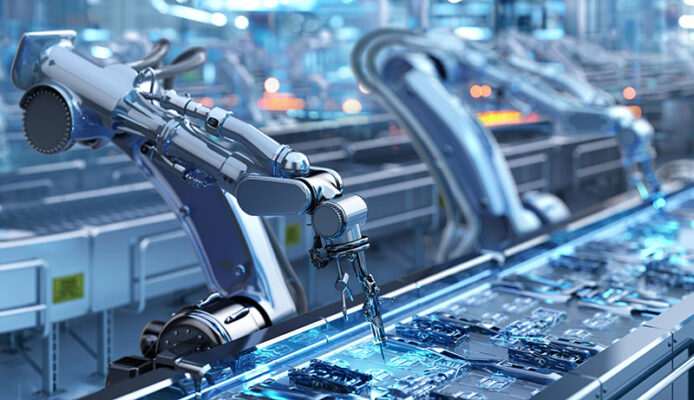
“5G and IIoT: Emerging Use Cases in …” from www.telit.com and used with no modifications.
Manufacturing environments have traditionally relied on wired connections for automation systems due to reliability and latency requirements. 5G’s ultra-reliable low-latency communication capabilities are changing this paradigm, enabling truly wireless factory automation with performance matching or exceeding wired systems. This wireless flexibility allows for more adaptive production layouts, easier reconfiguration for different products, and the integration of mobile robots that can move throughout the facility while maintaining precise control.
AI-powered quality control systems connected via 5G networks monitor production in real-time, using computer vision to identify defects with greater accuracy than human inspectors. These systems can analyze hundreds of products per minute, instantly flagging issues and adjusting production parameters to correct problems before they affect additional units. The combination of comprehensive monitoring and adaptive control has reduced defect rates by up to 80% in early implementations while increasing production speeds.
Perhaps most significantly, 5G-AI integration enables predictive maintenance systems that dramatically reduce unplanned downtime. Networks of sensors monitor equipment conditions continuously, with AI systems analyzing vibration patterns, temperature fluctuations, and other indicators to predict potential failures before they occur. Maintenance can then be scheduled during planned downtime periods, with augmented reality systems guiding technicians through precise repair procedures. These systems have reduced maintenance costs by up to 40% while increasing equipment availability by 10-15% in manufacturing environments.
Edge Computing: The Hidden Hero Making 5G-AI Magic Happen
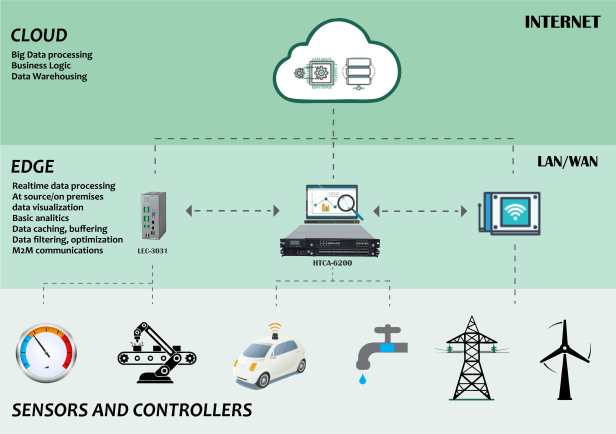
“5G: Edge Computing – Vividcomm” from vividcomm.com and used with no modifications.
Behind the visible applications of 5G and AI lies a critical enabling technology that’s transforming how data is processed and analyzed: edge computing. This approach moves processing power closer to where data is generated rather than sending everything to centralized cloud data centers. The combination of 5G networks and edge computing creates a distributed intelligence architecture that addresses fundamental challenges of latency, bandwidth efficiency, and privacy that would otherwise limit AI applications in many contexts.
Why Processing Data Locally Changes Everything
The traditional model of sending all data to centralized cloud servers for processing creates fundamental limitations for time-sensitive applications. Even with 5G’s improved latency, the physical distance to data centers introduces delays that can be problematic for applications like autonomous vehicles or industrial safety systems. Edge computing addresses this by placing processing capabilities directly at or near the data source, enabling immediate analysis and response without waiting for round-trip communication with distant servers.
This local processing capability is particularly valuable for AI applications that generate massive data volumes, such as video analytics or industrial sensor networks. Rather than transmitting raw data streams over the network, edge AI systems can perform initial processing locally, sending only relevant insights or anomalies to centralized systems. This approach dramatically reduces bandwidth requirements while improving system responsiveness, making previously impractical applications viable at scale.
Edge computing also provides critical advantages for privacy-sensitive applications by keeping personal or proprietary data local rather than transmitting it to external systems. Healthcare applications can perform initial analysis of patient data directly on monitoring devices, sending only anonymized insights to cloud systems. Similarly, manufacturing systems can analyze proprietary production data locally, protecting intellectual property while still benefiting from AI optimization capabilities.
How Edge Computing Slashes Response Times
The impact of edge computing on system response times goes beyond simple reductions in network latency. By distributing intelligence throughout the network, edge architectures enable multi-tier decision-making where time-critical functions happen locally while more complex analysis can still leverage cloud resources. Autonomous vehicles, for example, handle immediate safety decisions through onboard systems while using cloud-based AI for navigation optimization and traffic pattern analysis.
This tiered approach to processing creates resilient systems that can continue functioning even when connectivity is intermittent. Smart city applications maintain core functions during network disruptions, with edge systems continuing to control traffic lights, monitor environmental conditions, and coordinate emergency responses based on local data. When connectivity resumes, these systems synchronize with centralized platforms to incorporate broader context and optimization. To understand more about the infrastructure that supports these applications, you can explore what is edge computing.
For interactive applications like augmented reality, edge computing enables responsive experiences that would be impossible with cloud-only processing. AR headsets can perform object recognition and basic environment mapping locally, with cloud systems handling more complex tasks like detailed 3D rendering or accessing large knowledge databases. This hybrid approach delivers the immediacy needed for comfortable AR experiences while still leveraging the computational power of cloud systems for enhanced capabilities.
The Next Wave: 5G-AI Will Reshape These Industries First
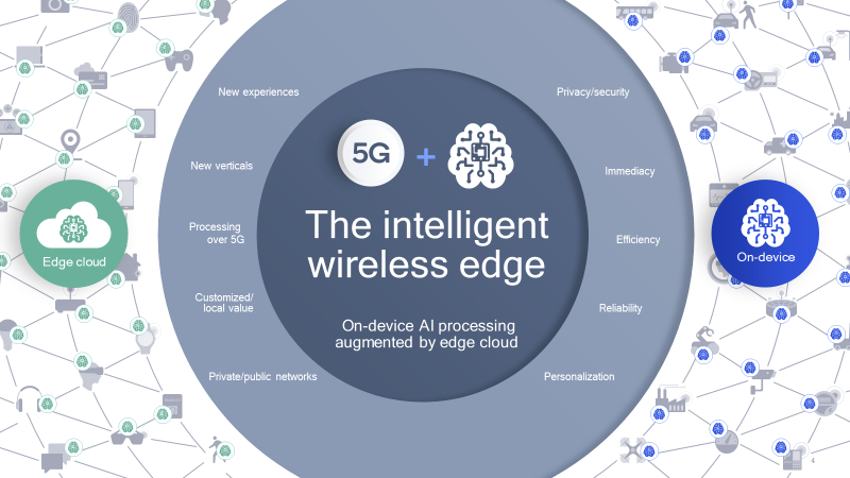
“5G+AI: The ingredients fueling tomorrow …” from www.qualcomm.com and used with no modifications.
The integration of 5G and AI technologies is creating a fundamental shift across the business landscape, with certain industries positioned to experience particularly dramatic transformations. Organizations that understand and leverage these changes early will gain significant competitive advantages, while those that delay risk falling behind as new operational models become standard. The industries at the forefront of this revolution share common characteristics: complex operations that generate massive data volumes, time-sensitive processes where latency matters, and operational environments where wireless flexibility provides meaningful benefits.
Manufacturing’s Smart Factory Transformation
Manufacturing is undergoing perhaps the most comprehensive transformation through 5G-AI integration, with smart factories implementing end-to-end connected systems that optimize every aspect of production. Autonomous mobile robots (AMRs) navigate factory floors freely, delivering materials precisely when and where needed based on real-time production data. Quality control systems using computer vision can inspect hundreds of products per minute with greater accuracy than human inspectors, automatically adjusting production parameters when deviations occur. The resulting efficiency gains have enabled some facilities to increase throughput by 20-30% while reducing defect rates by up to 80%.
Retail’s New Customer Experience
The retail sector is leveraging 5G-AI capabilities to blend physical and digital shopping experiences in ways that enhance customer satisfaction while optimizing operations. Smart shelves with integrated sensors track inventory in real-time, automatically triggering restocking and detecting potential theft, while computer vision systems analyze shopper behavior to optimize store layouts and staffing. For customers, augmented reality applications allow virtual try-on experiences for clothing, furniture placement visualization, and product information overlays when examining items in-store.
Personalization has reached new levels with 5G-connected systems that recognize returning customers (with permission) and provide customized recommendations based on past purchases and current behavior. Even pricing has become dynamic, with electronic shelf labels that can adjust based on inventory levels, time of day, or competitive positioning. These innovations are helping physical retailers compete more effectively with online alternatives by offering unique experiences that combine the immediacy of in-person shopping with the personalization of digital platforms.
For those interested in exploring the future of retail technology, keep an eye on AI startups to watch as they continue to drive innovation in this space.
Transportation Beyond Autonomous Vehicles
While autonomous vehicles capture headlines, the broader transportation sector is being reshaped by 5G-AI integration in ways that extend far beyond self-driving cars. Smart traffic management systems coordinate signals across entire cities based on real-time conditions, reducing congestion by up to 25% in early implementations. Public transit systems dynamically adjust routes and schedules based on demand patterns, with some agencies reporting 15-20% reductions in operating costs while improving service levels.
Logistics networks have become interconnected ecosystems where trucks, warehouses, distribution centers, and delivery vehicles share data continuously through 5G networks. AI systems optimize routing across multiple transportation modes, accounting for traffic conditions, weather events, and delivery priorities. The most advanced implementations can reconfigure entire distribution networks in minutes to respond to unexpected disruptions, rerouting shipments and reallocating resources to maintain service levels despite challenges.
| Transportation Application | 5G-AI Benefits | Measured Results |
|---|---|---|
| Smart Traffic Management | Real-time signal coordination based on actual conditions | 20-25% reduction in travel times, 15-30% decrease in emissions |
| Dynamic Public Transit | Demand-responsive routing and capacity adjustment | 15-20% operational cost reduction, 30% increase in ridership |
| Predictive Maintenance | Real-time vehicle monitoring with failure prediction | 35-40% reduction in unplanned downtime, 20% lower maintenance costs |
| Multimodal Logistics | Cross-platform optimization and disruption response | 15-25% reduction in delivery times, 10-15% lower operational costs |
Maritime and aviation sectors are similarly benefiting from 5G-AI systems that optimize operations while enhancing safety. Ports use connected cranes and autonomous vehicles to load and unload cargo with minimal human intervention, reducing turnaround times by up to 30%. Airports implement AI-powered systems for runway scheduling, baggage handling, and passenger flow management, improving capacity utilization while reducing delays.
The integration of these various transportation systems creates network effects where improvements in one area enhance performance across the entire ecosystem. When delivery vehicles communicate with traffic management systems, package routing algorithms can generate more accurate delivery estimates. When public transit systems share real-time capacity and location data, mobility-as-a-service platforms can offer truly seamless multimodal journey options that adapt to changing conditions.
Entertainment’s Immersive Future
The entertainment industry is leveraging 5G-AI capabilities to create more immersive, interactive experiences across multiple formats. Live events now offer augmented reality enhancements where spectators can access real-time statistics, alternative viewing angles, and interactive content through their devices. Some venues have implemented 5G-connected AR systems that overlay digital elements onto the physical performance space, creating mixed-reality experiences visible to all attendees through specialized glasses or smartphone screens.
Gaming has entered a new era with cloud-based systems that leverage 5G connectivity to deliver console-quality experiences to mobile devices. By handling complex processing in edge computing centers and streaming results to players, these platforms eliminate the need for expensive local hardware while enabling more sophisticated shared worlds and AI-driven experiences. The most advanced implementations use AI to generate dynamic content and scenarios in real-time, creating games that evolve continuously based on player actions and preferences.
The 5G-AI World Is Closer Than You Think
The technological foundation for a fully integrated 5G-AI ecosystem is being deployed more rapidly than many realize. Major carriers have already covered most urban areas with 5G networks, with midband spectrum deployments providing the optimal balance of coverage and capacity for AI applications. Edge computing infrastructure is expanding rapidly, with thousands of micro data centers being installed at cell towers, business districts, and transit hubs to support local processing requirements. For businesses and consumers alike, the opportunity to leverage these capabilities is not a distant future prospect but an immediate possibility that forward-thinking organizations are already exploiting to gain competitive advantages.
Frequently Asked Questions
As 5G and AI technologies become increasingly integrated into everyday experiences, consumers and businesses naturally have questions about how these systems will affect them. Understanding the practical implications of this technological shift can help organizations make informed decisions about implementation strategies and investment priorities. Below are answers to some of the most common questions about the convergence of 5G networks and artificial intelligence.
These questions reflect common concerns about the real-world impact of these technologies beyond technical specifications. The answers provide context for understanding how 5G-AI integration will affect both business operations and everyday experiences as these systems become more prevalent.
How much faster is 5G compared to 4G for AI applications?
While 5G networks theoretically offer speeds up to 100 times faster than 4G (10 Gbps versus 100 Mbps), the real-world benefit for AI applications is more nuanced than raw download speeds. The most significant improvement comes from latency reduction, with 5G networks capable of response times as low as 1 millisecond compared to 50-100 milliseconds for 4G. This dramatic reduction enables truly real-time AI applications like remote surgery, autonomous vehicle coordination, and industrial control systems that simply weren’t feasible with previous network generations. To understand more about the technology enabling these advancements, you can read about edge computing.
Beyond speed and latency, 5G networks also provide substantially higher connection density, supporting up to 1 million connected devices per square kilometer compared to around 4,000 with 4G. This capacity enhancement enables comprehensive sensor networks that generate the massive data volumes AI systems need for effective pattern recognition and predictive analytics. When combined with network slicing capabilities that allocate dedicated resources to critical applications, these improvements create a fundamentally different connectivity environment for AI systems that goes far beyond simple speed increases.
Will 5G and AI integration raise my phone bill?
The impact of 5G-AI integration on consumer costs is complex and depends largely on usage patterns and service provider strategies. Basic 5G connectivity has generally been included in existing data plans without significant price increases as carriers compete for market share. However, premium AI-enhanced services that require substantial network resources or specialized edge computing capabilities may come with additional costs, particularly for business applications with specific performance requirements.
For consumers, the most noticeable cost impact may come from increased data consumption rather than higher base rates. AI-enhanced applications like augmented reality, cloud gaming, and high-definition video analytics naturally consume more data than traditional mobile applications. While 5G plans typically include larger data allowances than previous-generation services, heavy users of these advanced applications may need to purchase expanded data packages. The good news is that increasing competition in the 5G market has generally led to more generous data allowances at comparable price points to previous 4G plans. For more on how technology is evolving, you might be interested in learning what is edge computing.
What’s the biggest obstacle to widespread 5G-AI adoption?
While technical challenges like comprehensive network coverage receive significant attention, the most substantial obstacle to widespread 5G-AI adoption is actually organizational rather than technological. Many businesses lack the internal expertise to effectively implement and leverage these technologies, particularly when it comes to integrating AI capabilities with existing operational systems and processes. This knowledge gap creates significant challenges for organizations attempting to transition from proof-of-concept projects to full-scale implementations that deliver measurable business value.
- Talent shortages in specialized roles like 5G network engineering, edge computing architecture, and AI model development
- Integration challenges with legacy systems that weren’t designed for real-time data processing
- Difficulty quantifying return on investment for transformative technologies that affect multiple business functions
- Security and privacy concerns, particularly regarding data collection and processing at the edge
- Regulatory uncertainty around spectrum allocation, data governance, and AI ethics
To overcome these obstacles, forward-thinking organizations are forming cross-functional teams that combine technical expertise with domain knowledge and change management capabilities. These teams can bridge the gap between technology possibilities and business requirements, developing implementation strategies that address both technical requirements and organizational readiness. Partnerships with specialized service providers and technology vendors can also help organizations access expertise and accelerate implementation timelines.
Educational initiatives are equally important, with many organizations investing in training programs to build internal capabilities related to 5G and AI technologies. These programs focus not just on technical skills but also on applications and use cases relevant to specific business contexts, enabling teams to identify and pursue high-value opportunities. As these capabilities become more widespread, adoption barriers will naturally decrease, accelerating the integration of these technologies across industries.
Can my current devices take advantage of 5G-AI capabilities?
Device compatibility varies significantly depending on the specific 5G-AI application and the capabilities of your existing hardware. Most smartphones manufactured in the past two years include 5G connectivity, though they may support different frequency bands with varying performance characteristics. The AI processing capabilities of these devices also differ substantially, with higher-end models including specialized neural processing units that enable on-device AI functions. For basic AI-enhanced services that primarily leverage cloud processing, any 5G-capable device should provide adequate performance. However, more sophisticated applications that require local AI processing may deliver better experiences on devices with dedicated AI hardware.
How is China’s 5G-AI development comparing to the US and Europe?
China has pursued an aggressive national strategy for 5G deployment and AI development, resulting in the world’s largest 5G network with over 1.4 million base stations and 500 million users as of early 2023. This infrastructure advantage has enabled widespread implementation of 5G-AI applications in manufacturing, transportation, and smart city environments at scales not yet matched in Western markets. Chinese companies have particularly focused on industrial applications, developing specialized solutions for factory automation, quality control, and supply chain optimization that leverage the country’s manufacturing ecosystem.
The United States has taken a different approach, focusing on innovation in software platforms, edge computing architectures, and specialized AI applications rather than raw deployment numbers. American companies lead in developing cloud-to-edge AI platforms, autonomous vehicle technologies, and advanced healthcare applications. This focus on high-value applications and platform development has created an ecosystem where specialized capabilities can be deployed quickly once network infrastructure becomes available.
Europe has emphasized standardization, security, and ethical frameworks for 5G-AI deployment, creating a more regulated but potentially more sustainable approach to implementation. European organizations have made particularly strong progress in industrial IoT applications, smart energy systems, and transportation optimization. The region’s emphasis on data protection and ethics-by-design has also influenced global approaches to responsible AI deployment in network environments. To stay competitive in the rapidly evolving 5G-AI landscape, businesses should monitor developments across all three regions, adapting and implementing the most relevant innovations regardless of their origin.
As these technologies continue to mature and converge, the ability to leverage insights from global implementation examples will become increasingly valuable. Organizations that can effectively combine China’s scale, America’s innovation, and Europe’s governance models will be best positioned to maximize the benefits of 5G-AI integration while minimizing associated risks. Market Business Watch continues to track these developments across regions, providing insights that help businesses navigate the complex landscape of connectivity and intelligence technologies.

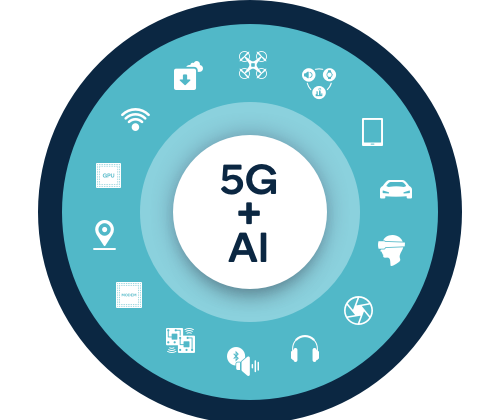
Join the Conversation